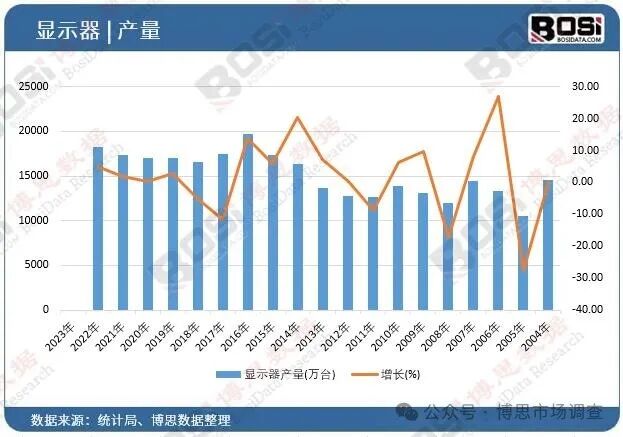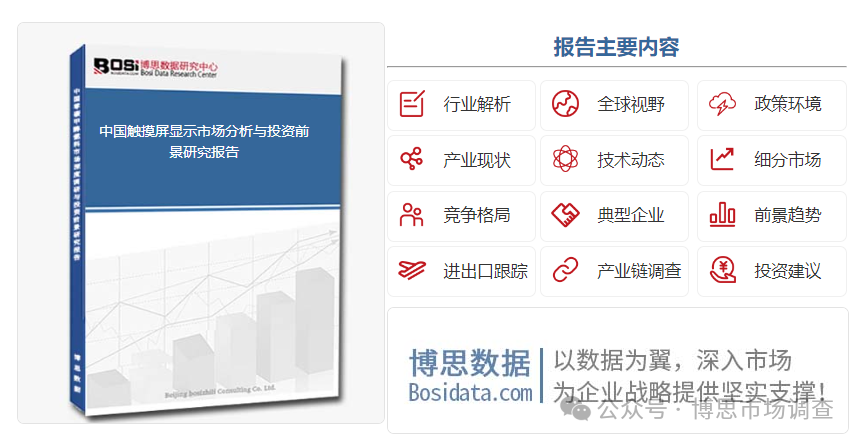1. Overview of Industry Concepts Touch screen display technology is a method of human-computer interaction realized through electronic device screens, widely used in smartphones, tablets, laptops, industrial control devices, medical equipment, and other fields. Touch screens can be classified into resistive, capacitive, infrared, and acoustic types based on their working principles, with capacitive screens becoming mainstream due to their high sensitivity and good stability. With continuous technological advancements, new products such as flexible OLED touch screens and foldable touch screens are gradually emerging, driving innovation and development in the industry.
2. Market Characteristics
-
Market Size and Growth According to relevant data, the touch screen display market in China has maintained stable growth in recent years. The global touch screen market is expected to reach hundreds of billions of dollars by 2024, with the Chinese market occupying an important position as a major production base.
- Regional Distribution: The North China, East China, and South China regions are the main concentrations of the touch screen display market in China, with East China developing the fastest due to its strong industrial foundation.
- Segmented Markets: Consumer electronics (such as smartphones and tablets) are the largest application field, followed by industrial control and medical equipment.
Industry Chain Structure The touch screen industry chain includes upstream raw material supply (such as glass substrates and touch sensors), midstream module production, and downstream terminal applications. In recent years, the domestic industry chain has gradually improved, but the issue of relying on imports for upstream raw materials still exists.
Competitive Landscape The domestic touch screen market is highly competitive, with major companies including BOE Technology Group, TCL China Star Optoelectronics Technology, and Truly Opto-electronics. These companies dominate in technology research and development and market share, but small and medium-sized enterprises face significant survival pressure.

3. Current Industry Status
-
Technological Innovation Capacitive screens are gradually replacing resistive screens as the mainstream, and the application of flexible OLED and foldable screen technologies is accelerating. Additionally, the popularity of full lamination technology has made touch screen display products thinner and lighter.
- Flexible Display Technology: Flexible OLED touch screens, due to their bendable and foldable characteristics, are penetrating into fields such as wearable devices.
- Integration Trend: The deep integration of touch screens with display panels and biometric technologies has enhanced the intelligence level of products.
Market Demand With the development of 5G, the Internet of Things, and artificial intelligence technologies, the application demand for touch screen display technology in emerging fields such as smart homes and smart cars is continuously increasing. Moreover, the pandemic has driven the demand for remote work and online education, further stimulating the sales of touch screen display devices.
Policy Support National policies supporting the manufacturing of electronic special equipment provide a favorable external environment for the development of the touch screen industry.
4. Future Trends
-
Direction of Technological Innovation
- New Materials and Structures: Exploring new materials and structures to enhance the durability and sensitivity of touch screens.
- Intelligence and Integration: Touch screens will be deeply integrated with AI and biometric technologies to achieve a smarter operating experience.
- Flexible Display Technology: The further popularization of flexible OLED and foldable screen technologies will drive the development of wearable devices and in-vehicle display markets.
Market Demand Trends High definition, flexibility, and intelligence are the main development directions for future touch screen display technology. As consumer demand for high-quality display devices increases, the market demand for high-end touch screen modules will continue to grow.
Regional Development East China will continue to maintain its leading position, while the central and western regions are expected to become new growth points due to policy support and technology transfer.
5. Challenges and Opportunities
-
Challenges
- Technical Barriers: Core technologies for high-end touch screens are still controlled by foreign companies, and domestic enterprises need to increase R&D investment.
- Market Competition: Small and medium-sized enterprises face significant survival pressure, and there is a clear trend of industry consolidation.
- International Trade Environment: International trade frictions may affect raw material supply and export business.
Opportunities
- Policy Support: National support for the manufacturing of electronic special equipment provides a guarantee for industry development.
- Demand in Emerging Fields: The growing demand in emerging fields such as smart homes and smart cars brings new market space for the touch screen industry.
- Driven by Technological Innovation: The popularization of flexible display technology and full lamination technology will drive industry upgrades.
6. Conclusion The Chinese touch screen display market is in a rapid development stage, with technological innovation and market demand being the core driving forces for industry development. Despite facing challenges such as technical barriers and market competition, the industry has broad prospects driven by policy support and demand in emerging fields. In the future, companies need to focus on technological R&D and industry chain integration to seize development opportunities.
In this process, Bosi Data will continue to pay attention to industry dynamics, providing accurate and timely market analysis and advice for related enterprises and investors.
